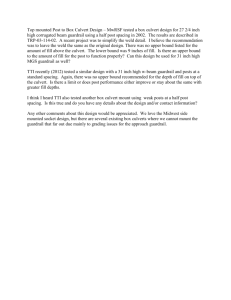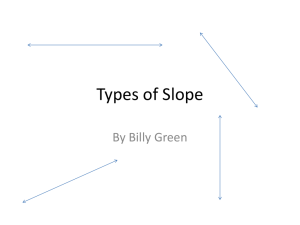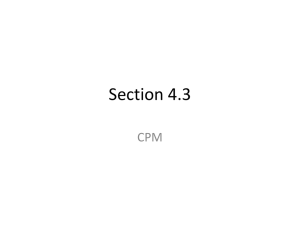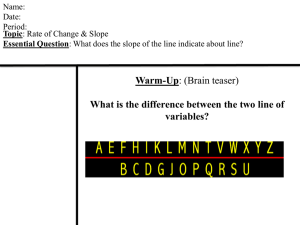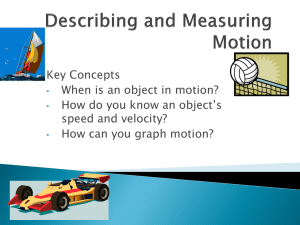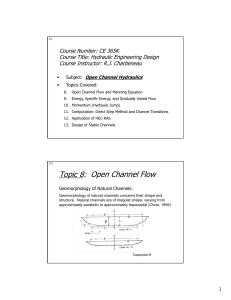26 Open Channels
advertisement
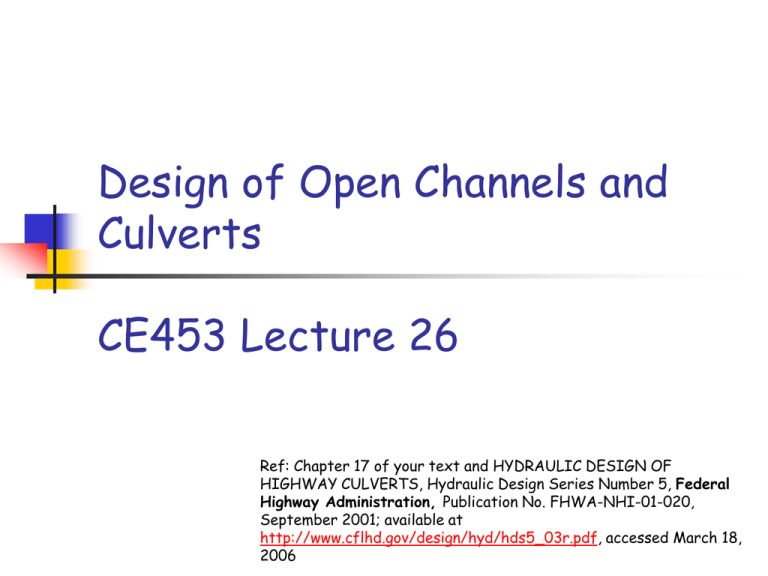
Design of Open Channels and Culverts CE453 Lecture 26 Ref: Chapter 17 of your text and HYDRAULIC DESIGN OF HIGHWAY CULVERTS, Hydraulic Design Series Number 5, Federal Highway Administration, Publication No. FHWA-NHI-01-020, September 2001; available at http://www.cflhd.gov/design/hyd/hds5_03r.pdf, accessed March 18, 2006 Design of Open Channels Longitudinal Slopes Gradient longitudinal direction of highway to facilitate movement of water along roadway Drains Along ROW Collect surface water A Typical intercepting drain placed in the impervious zone http://www.big-o.com/constr/hel-cor.htm Drainage Channels (Ditches) Design Adequate capacity Minimize hazard to traffic Hydraulic efficiency Ease of maintenance Desirable design (for safety): flat slopes, broad bottom, and liberal rounding Ditch Shape Source: Fabriform1.com Trapezoidal – generally preferred considering hydraulics, maintenance, and safety V-shaped – less desirable from safety point of view and maintenance Terms Steady Flow: rate of discharge does not vary with time (Manning’s applies) Uniform: channel properties are constant along length of channel Slope Roughness Cross-section Water surface is parallel to slope of channel Non-uniform: properties vary Terms Unsteady flow: rate of discharge varies with time Critical depth a hydraulic control in design depth of water where flow changes from tranquil to rapid/shooting Critical velocity: velocity corresponding to critical depth Critical slope: slope corresponding to critical depth Flow Velocity • • Depends on lining type Should be high enough to prevent deposit of transported material (sedimentation) • • For most linings, problem if S < 1% Should be low enough to prevent erosion (scour) • For most types of linings, problem if S > 5% Use spillway or chute if Δelev is large Rip Rap for drainage over high slope Riprap (TN Design Manual) Side Ditch/Open Channel Design-Basics • • • • Find expected Q at point of interest (see previous lecture) Select a cross section for the slope, and any erosion control needed Manning’s formula used for design Assume steady flow in a uniform channel Manning’s Formula V = R2/3*S1/2 n (metric) V = 1.486 R2/3*S1/2 n where: V = mean velocity (m/sec or ft/sec) R = hydraulic radius (m, ft) = area of the cross section of flow (m2, ft2) divided by wetted perimeter (m,f) S = slope of channel n = Manning’s roughness coefficient Side Ditch/Open Channel Design-Basics Q = VA Q = discharge (ft3/sec, m3/sec) A = area of flow cross section (ft2, m2) FHWA has developed charts to solve Manning’s equation for different cross sections Open Channel Example Runoff = 340 ft3/sec (Q) Slope = 1% Manning’s # = 0.015 Determine necessary cross-section to handle estimated runoff Use rectangular channel 6-feet wide Open Channel Example Q = 1.486 R2/3*S1/2 n Hydraulic radius, R = a/P a = area, P = wetted perimeter P Open Channel Example Flow depth = d Area = 6 feet x d Wetted perimeter = 6 + 2d Flow depth (d) 6 feet Example (continued) Q = 1.486 a R2/3*S1/2 n 340 ft3/sec = 1.486 (6d) (6d)2/3 (0.01)1/2 (6 + 2d) 0.015 d 4 feet Channel area needs to be at least 4’ x 6’ Example (continued) Find flow velocities. V = 1.486 R2/3*S1/2 n with R = a/P = 6 ft x 4 ft = 1.714 2(4ft) + 6ft so, V = 1.486(1.714)2/3 (0.01)1/2 = 14.2 ft/sec 0.015 If you already know Q, simpler just to do V=Q/A = 340/24 = 14.2) Example (continued) Find critical velocities. From chart along critical curve, vc 13 ft/sec Critical slope = 0.007 Find critical depth: yc = (q2/g)1/3 g = 32.2 ft/sec2 q = flow per foot of width = 340 ft3/sec /6 feet = 56.67ft2/sec yc = (56.672/32.2)1/3 = 4.64 feet > depth of 4’ Check lining for max depth of flow … Rounded A cut slope with ditch A fill slope Inlet or drain marker Ditch treatment near a bridge US 30 – should pier be protected? A fill slope Hidden Drain Where’s the water going to end up? Median drain Design of Culverts Source: Michigan Design Manual Culvert Design - Basics Top of culvert not used as pavement surface (unlike bridge), usually less than 20 foot span > 20 feet use a bridge Three locations Bottom of Depression (no watercourse) Natural stream intersection with roadway (Majority) Locations where side ditch surface drainage must cross roadway Hydrologic and Economic Considerations Alignment and grade of culvert (wrt roadway) are important Similar to open channel Design flow rate based on storm with acceptable return period (frequency) Culvert Design Steps Obtain site data and roadway cross section at culvert crossing location (with approximation of stream elevation) – best is natural stream location and slope (may be expensive though) Establish inlet/outlet elevations, length, and slope of culvert Sometimes … you want a dam … why? Culvert Design Steps Determine allowable headwater depth (and probable tailwater depth) during design flood – control on design size – f(topography and nearby land use) Select type and size of culvert Examine need for energy dissipaters Headwater Depth Constriction due to culvert creates increase in depth of water just upstream Allowable/desirable level of headwater upstream usually controls culvert size and inlet geometry Allowable headwater depth depends on topography and land use in immediate vicinity Inlet control Flow is controlled by headwater depth and inlet geometry Usually occurs when slope of culvert is steep and outlet is not submerged Supercritical, high v, low d Most typical Following methods ignore velocity head Example: Design ElevHW = 230.5 (max) Stream bed at inlet = 224.0 Drop = 6.5’ Peak Flow = 250cfs 5x5 box HW/D = 1.41 HW = 1.41x5 = 7.1’ Need 7.1’, have 6.5’ Drop box 0.6’ below stream @223.4’ - OK Outlet control When flow is governed by combination of headwater depth, entrance geometry, tailwater elevation, and slope, roughness, and length of culvert Subcritical flow Frequently occur on flat slopes Concept is to find the required HW depth to sustain Q flow Tail water depth often not known (need a model), so may not be able to estimate for outlet control conditions Example: Design ElevHW = 230.5 Flow = 250cfs 5x5 box (D=5) Stream at invert = 224 200’ culvert Outlet invert = 224-0.02x200 = 220.0’ (note: = 223.4.017x200) Given tail water depth = 6.5’ Check critical depth, dc = 4.3’ from fig. 17.23 Depth to hydraulic grade line = (dc+D)/2 = 4.7 < 6.5, use 6.5’ Example (cont.) Design ElevHW = 230.5 Flow = 250cfs 5x5 box Outlet invert = 220.0’ Depth to hydraulic grade line = 6.5’ Head drop = 3.3’ (from chart) 220.0+6.5+3.3 = 229.8’<230.5 OK


